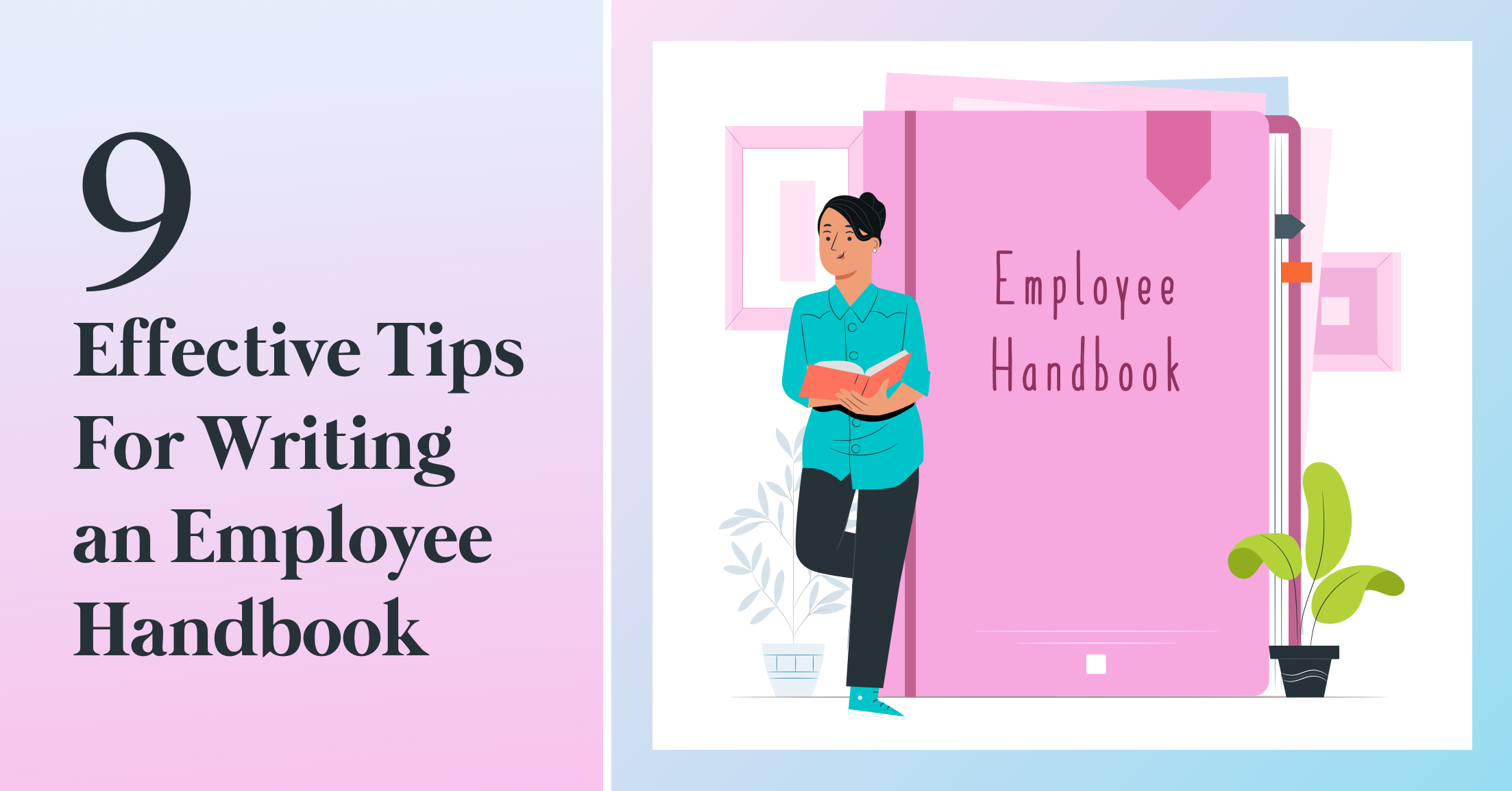- The Importance of Writing An Employee Handbook
- 9 Tips That’ll Make Your Employee Handbook Effective
- 1. Keep It Simple & Engaging
- 2. Use Your Handbook As A Communication Tool
- 3. Pay Attention to Format and Visuals
- 4. Clearly Mention Work Hours, Compensations, and Benefits
- 5. Mention Your Company Culture & How Employees Can Maintain The Same
- 6. Mention Legal Issues
- 7. Mention Employee Appreciation
- 8. Keep Room For Improvement
- 9. Give To An Employee For Feedback


 Cut onboarding time
by 60%—here's the
Ultimate Checklist
that helped do it.
Cut onboarding time
by 60%—here's the
Ultimate Checklist
that helped do it.

All companies should have employee handbooks. Unfortunately, even at companies that do use them, some employees do not read employee handbooks. Based on GuideSpark data, 43% of millennials do not read the entire handbook. Worse, 11% don’t open the handbook at all.
So, how do you avoid this situation and get all your employees to read? By writing the employee handbook the right way. In this article, let’s look at nine useful tips for creating a handbook that enhances employee engagement and retention. But first, let’s answer this question: why does your company need an employee handbook in the first place?
The Importance of Writing An Employee Handbook
The employee handbook contains everything an employee needs to know about working in the organization. It doesn’t only explain the company’s rules and regulations. It also reflects the latest labor laws and social norms that all employees and the company need to abide by. Moreover, a well-crafted handbook can significantly impact employee satisfaction and motivation.
According to Paycor, there are eight reasons a company should have an employee handbook:
-
It introduces employees to culture, mission, and values.
-
It communicates to employees what is expected of them.
-
It educates employees about what they can expect from management.
-
It communicates company policies clearly.
-
It showcases the benefits the company offers.
-
It ensures compliance with federal and state laws.
-
It helps defend against employee claims.
-
It is where employees can turn to for help.
In other words, without an employee handbook, companies can expect a lack of organization and clarity in the workplace, which can negatively impact employee engagement and retention. A Professional writing service can help you create an employee handbook that is not only informative but also engaging to read, ultimately boosting job satisfaction and employee motivation.
9 Tips That’ll Make Your Employee Handbook Effective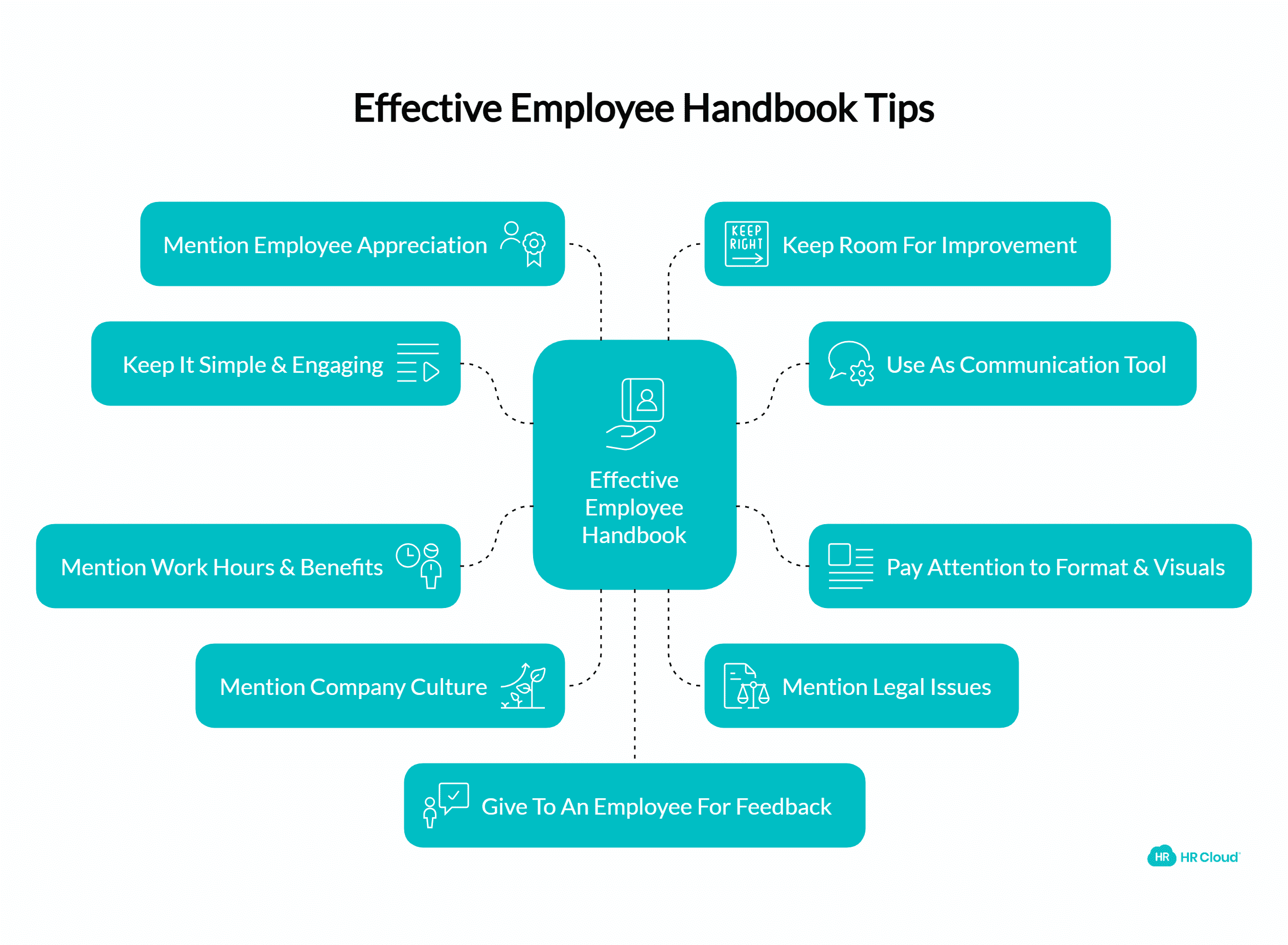
So you’ve decided to write an employee handbook. In this section, let’s look at nine tips you need to follow to get your employees to read it and enhance employee engagement and recognition in the process.
1. Keep It Simple & Engaging
Let’s face it. Employee handbooks can be very dull. There’s nothing particularly exciting about most companies’ mission or vision. Unless you have a legal background, chances are you wouldn’t get past the first few lines in the section on federal and state employment law.
Then, to boost readability and employee engagement, shake things up a bit. Present your employee handbook in a fun and innovative way. Your employee handbook doesn’t have to sound serious or use legalese. Use engaging and straightforward language so your employees will understand even the most complex concepts, improving overall employee satisfaction.
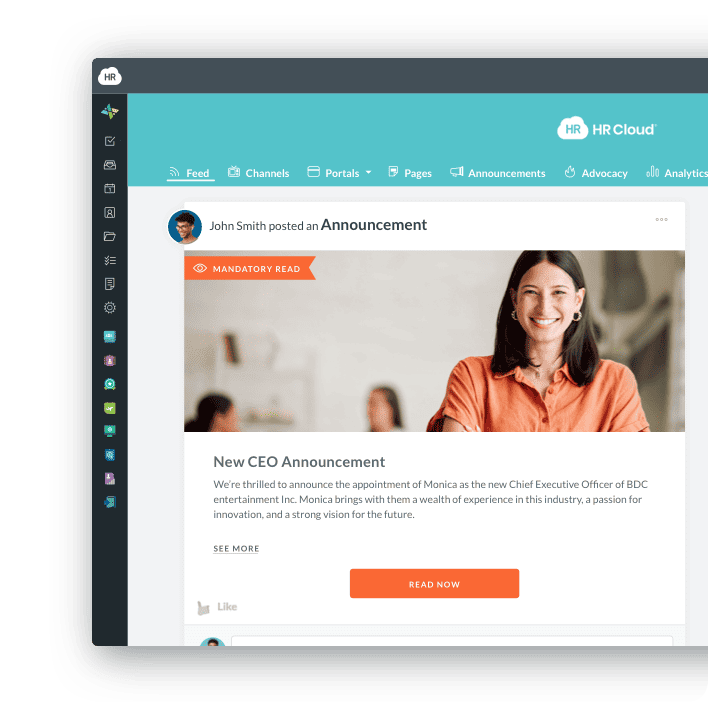
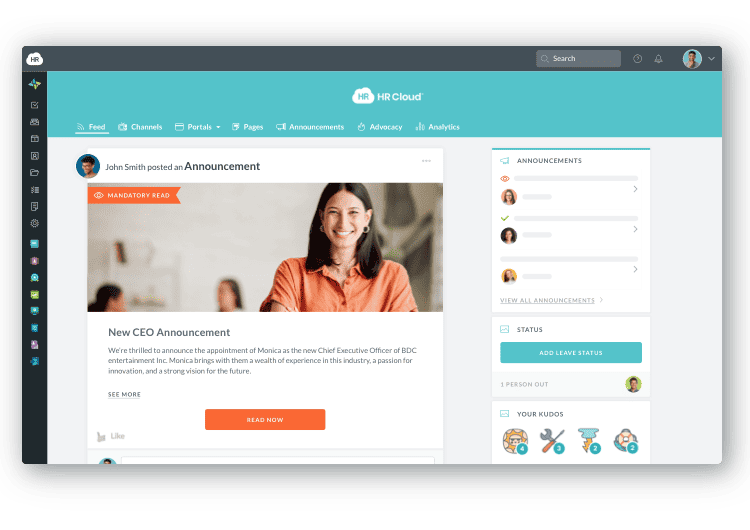
2. Use Your Handbook As a Communication Tool
You should use your handbook to communicate with your employees and foster employee recognition and engagement. In other words, don’t just fill it with legal terms and parrot your company’s mission and vision. Use it to reach out and explain what you expect from your employees - and what they can expect from you, too.
Don’t make your employee handbook sound authoritarian. Instead, treat your employees like adults who are partners in your company’s success. Let your employees feel that management is there for them, but that they need to do their part, too.
Make it clear as well that while the handbook is there to guide them, employees can always approach you for any questions or clarification. Management is there to listen. If you reflect that in your employee handbook, your employees won’t ever feel alienated. Remember, effective communication improves employee trust and engagement , which are crucial for employee retention
3. Pay Attention to Format and Visuals
Employee handbooks don’t have to contain just chunks of text. You can include pictures and illustrations inside to help illustrate concepts, too. You can also put them on the cover to instantly grab your employees’ attention. Do this, and you will boost your employee handbook’s readability and overall employee engagement. According to Forbes, 91% of people prefer visual content to text-based content.
Images aren’t the only things you can use to make your employee handbook readable. Use plenty of headings, sub-headings, bullet points, and paragraph breaks, too. They will make your handbook skimmable and easy to read. When employees are looking for a specific section in the handbook, they won’t have difficulty finding it.
Valve uses all these elements to get its employees to read the company handbook. Apart from numerical lists, the company uses illustrations to inject humor into its pages:
The language throughout the handbook is conversational, too.
4. Clearly Mention Work Hours, Compensation, and Benefits
A company’s employee handbook should be for employees. That means you should include in that handbook everything they need to know to be productive in the organization. That includes compensation and benefits, work hours, and leave allowance.
You have to be as clear as possible. For example, if employees are paid by the hour, and an employee time clock app determines their work hours, say so. On the other hand, if they are salaried and expected to work certain core hours each day, explain that, too.
The more specific you are about these things in your employee handbook, the better for your employees. This clarity contributes to employee satisfaction and can positively impact employee retention. This will ensure the company is protected in the unlikely event that suits are filed since nothing is subject to misinterpretation.
5. Mention Your Company Culture & How Employees Can Maintain The Same
Built-in defined company culture as the “set of shared values, goals, attitudes, and practices that characterize an organization.” In other words, it is your company’s shared ethos.
Don’t make your employees guess what the company culture is. You have to explicitly explain in your employee handbook the company’s core values that drive all workplace actions.
For example, for Facebook, that core value is to “be bold.” That shows in the way they push things to the limit with their innovations on the social media platform, even when some of them backfire. For Uber, it’s “we do the right thing, period.” And that showed when the company parted with its former CEO, Travis Kalanick, after a shareholder revolt.
If you explain the company culture in the handbook, you can facilitate the onboarding process for new hires. There are ways you can hook new hires with your company culture, too. Your explicit statements about your shared ethos will also serve as a reminder to existing employees as they work.
Include in your handbook how your employees can maintain that company culture, too, to ensure a positive working environment for everyone, which is crucial for employee engagement and retention.
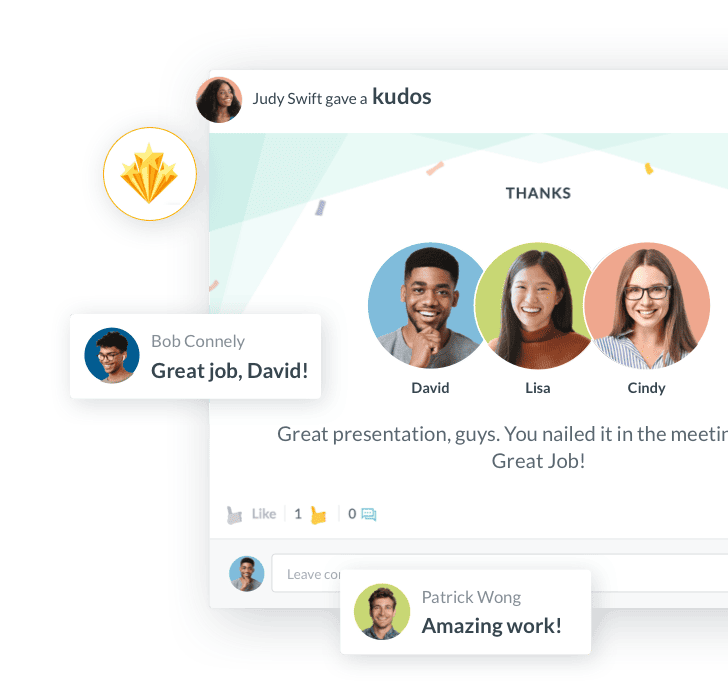

6. Mention Legal Issues
Your employee handbook must include any legal content your employees need to know. It should have a section that explains specific laws that may be relevant to them in the future. According to Square Up, these include equal employment and non-discrimination laws, anti-harassment laws, and workers’ compensation laws. Some US states explicitly state the specific legal content you need to have in your handbook. It should include possible real-world scenarios to illustrate the concepts in practice, too.
It’s best not to try to create this section by yourself. Ideally, consult a lawyer during or after writing them. Remember, your employees have a copy of the handbook and use it as a guide. The handbook also reflects the company’s official stand. If you make a mistake there, employees who feel the company has wronged them can always come back and use it against you if they file a legal complaint.
Many companies make mistakes in the handbook and take it very lightly. Employees bookmark the handbook and refer to it on a regular basis. So it is extremely important that you take care of mistakes and inform every employee.
In case of committing such mistakes, immediately schedule and send emails to all the employees at a suitable time. As an HR, you have to make sure every employee should recognize the mistake in the current handbook and receive an updated copy in email.
7. Mention Employee Appreciation
The employee handbook should contain the programs the company has for recognizing and rewarding employees. Employee recognition programs are the cornerstone of great workplace cultures and play a crucial role in employee engagement and retention. If you make it clear from the start that the company recognizes and rewards its employees, new hires will be motivated to give it their all at work starting from day 1.
The employee handbook should define what exactly constitutes great performance, too. For example, suppose the company values efficiency above anything else and considers the employee schedule template as sacred. In that case, it won’t hesitate to recognize an employee who strictly adheres to their work schedule for an entire year. In another company, employees may be permitted to set their own hours and be judged purely on output.
Here’s an example:
The rewards for employees can come in different forms as part of your employee rewards and recognition strategy. They can be monetary or a kind gesture, like an overseas trip, additional leave time, or a gift card. Whatever your rewards are, you have to be clear about how exactly an employee can earn them. Recognizing and rewarding your employees will bring them up to the next level and significantly boost employee motivation and job satisfaction!
8. Keep Room For Improvement
Your job doesn’t end after you finish writing the employee handbook. This is because as your company grows, the way you conduct business and your corporate policies are likely to change, too. That means you’d have to revise your handbook again so it can reflect those changes, including updates to your employee recognition and engagement programs.
Schedule a periodic review of your employee handbook so it will always be up-to-date. Once a year is good, but more frequent reviews might be necessary, depending on your company’s rate of change. To make distribution and updates more efficient, consider using one of the top PDF organizers to compile, edit, and manage your employee handbook digitally. This ensures every team member has access to the most current version with minimal hassle.
When making revisions, take the opportunity to look at laws that may have changed as well. Laws are not permanent and may be amended or revised. Just make sure you consult a lawyer again when you do this to avoid mistakes.
9. Give To An Employee For Feedback
Once you’ve completed the company employee handbook, it’s always a great idea to give it to a group of your employees for feedback. They are best placed to tell you if the handbook is readable and whether the user experience is excellent or needs improvement.
Employees can also give you feedback on the handbook’s content, including the effectiveness of your employee recognition and rewards programs. Remember, when you wrote the handbook, you did so from the perspective of management. That means some of what you wrote may have been skewed towards management. Some employee concerns may have been left out, even if you didn’t intend to do so.
If you get feedback from employees, you can adequately determine if a handbook is ready to roll out more widely. This process of seeking employee feedback itself can contribute to improved employee engagement and job satisfaction.
Bottom line
Employee handbooks are vital to any business. They ensure that everyone in the company is on the same page and aiming for the same goals. Employee handbooks also serve as a guide for both managers and employees. They keep processes in the company uniform and organized.
Since employee handbooks are so important, they can’t be written in a hurry. You need to put a lot of thought into what you write. You need to think of your target audience and balance their needs and wants with those of management and the company’s goals, too.
Moreover, a well-crafted employee handbook can significantly impact employee engagement and retention. By clearly outlining employee recognition programs, reward systems, and opportunities for growth, you can boost employee morale and job satisfaction. Remember that the handbook is not just a set of rules, but a tool for fostering a positive workplace culture that values and appreciates its employees.
Follow all the tips I gave you, and you’ll have that employee handbook that’s one for the books – a handbook that not only informs but also engages, motivates, and helps retain your valuable employees. 
FAQs
● Why is an employee handbook important for employee engagement and retention?
This targets users searching for strategic benefits and aligns with decision-makers seeking ROI from handbook updates.
● What should be included in an employee handbook to improve motivation and satisfaction?
Focuses on content relevance; good for targeting HR managers and business owners.
● How do you make an employee handbook engaging and easy to read?
A common concern—targets queries around readability, format, and employee adoption.
● How often should you update your employee handbook?
Captures users looking for compliance and operational best practices.
● What’s the role of company culture in an employee handbook?
This keyword combination is trending for companies trying to boost cultural alignment.
● How can you use an employee handbook for employee recognition and rewards?
Combines intent-driven keywords: “handbook” + “recognition” + “rewards” = high engagement.
● What are the legal requirements for an employee handbook?
Addresses compliance-based searches, especially in the U.S. market.
● How do you get employees to actually read the handbook?
Addresses the pain point cited in the intro stats (43% of millennials don’t read it). Also highly relatable.
About the author: Owen Jones is the Senior Content Marketer at ZoomShift - an online schedule
maker app. He is an experienced SaaS marketer, specializing in content marketing, CRO, and FB advertising. He likes to share his knowledge with others to help them increase results.
Keep Reading
The Hidden Metrics of Frontline Success: Beyond Engagement Scores
"What gets measured gets managed, but what gets measured well gets transformed." — Peter
Embracing Diversity: Recognizing Different Cultures in the Workplace
Workplaces today reflect the incredible diversity of the world around us. People bring
From Manual to Automated: A Complete Guide to Digitizing Employee Onboarding for Large Organizations
Sarah Chen, Director of HR at a 7,000-employee healthcare organization, starts her Monday
Like What You Hear?
We'd love to chat with you more about how HR Cloud® can support your business's HR needs. Book Your Free Demo

Build a Culture of Recognition. Boost Engagement. Guaranteed.
Workmates empowers employees to stay informed, connected, and appreciated—whether they’re on the front line, in the office, or remote. Recognition drives 12x higher engagement.Trusted by industry leaders in every sector




Cut Onboarding Costs by 60%.
Take the confusion and follow-ups out of onboarding with automated workflows, digital forms, and structured portals—so new hires ramp faster 3X quicker.Trusted by industry leaders in every sector




